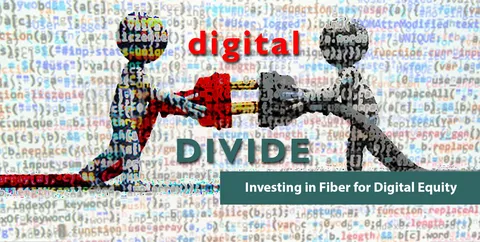
The gap between those with digital access and those without is quickly shaping the new face of inequality in the age of technology. At the same time, the growth of the internet outpaces even our most wild-eyed projections; millions whom we never see or hear are still shut out from its possibilities. InternetChicks.con and many other forums, what began as a digital living room for women has since evolved into both an ode to the possibilities of inclusivity online and a sad relic of the limitations many continue to face.
This blog considers the frightening extent of the digital divide, considering its devastating effects and the pressing issues of digital equity and inclusion.
Grasping the Scale of the Digital Divide
Access to the internet is no longer a luxury; it is a foundational resource for economic, educational, and social engagement. Yet, global disparities are stark:
- Approximately 2.7 billion people worldwide still lacked internet access by the end of 2023 (ITU).
- Regional Gaps: Sub-Saharan Africa has an internet penetration rate below 40%, while North America and Europe routinely exceed 85%.
- Rural vs. urban: Rural areas frequently experience lower connection speeds and reliability than urban centres, perpetuating cycles of disadvantage.
The consequences are visible. Where connectivity falters, opportunities dwindle, and communities find themselves locked out of the modern digital economy.
Socio-economic Consequences
Disparities in internet access fuel economic stagnation, reinforce social isolation, and limit democracy:
- Education: Students without connectivity cannot participate in digital learning environments or complete online assignments, amplifying educational inequalities.
- Employment: Entire populations remain sidelined from job opportunities, especially as remote and gig work models surge globally.
The numbers are the first evidence that something has to be done about these imbalances. The very meteoric rise of the internet reveals that there’s a lot at stake. The web is growing by one exabyte a day, the equivalent of 250 million DVDs. Those stranded are deprived of an ocean of knowledge and resources.
The Consequences of Limited Access
Economic Impact
Without access to the internet, one is potentially impeded from seeking, obtaining, or maintaining employment, and thus, being able to support oneself without substantial finite assistance from others. As jobs follow the work online, and as entrepreneurial opportunities multiply, digital exclusion locks in poverty. But the wave of online education, which is being driven by outfits like Coursera and Khan Academy, leaves behind anyone without the elementary connectivity. Global marketplaces like Etsy or Upwork are out of reach for micro-entrepreneurs.
Educational Inequality
The pandemic laid bare the stark reality of digital homework gaps. Students who lacked consistent internet had to hunt for public Wi-Fi or forgo joining. Poor academic achievement and higher rates of dropping out are associated with a lack of a digital toolkit.
- Even in developed economies, research finds that over 10% of students cannot reliably access online resources at home.
- Developing countries face steeper challenges, with entire communities sometimes sharing a single digital device.
Social and Health Disparities
Isolation is sometimes forgotten in the list of symptoms that the digital divide can cause. Restricted information access stifles social inclusion and limits participation in civic and cultural affairs. The ramifications for health are sobering:
- 52% of smartphone users seek health information via mobile devices, but if connectivity or devices are lacking, telehealth and health literacy fall out of reach (Business Insider).
- Rural and marginalised groups experience poorer outcomes as healthcare becomes increasingly digital-first.
Political and Democratic Exclusion
Civic engagement is heavily mediated through digital platforms. With limited access, individuals may:
- Miss out on critical information during election cycles
- Remain uninformed on local or national policy debates
- Be unable to participate in online forums, advocacy, and petitions
This fractures democratic processes and erodes the legitimacy of institutions claiming to represent all constituents.
Drivers of the Digital Divide
Understanding the mechanisms driving digital exclusion is fundamental for policy and practical solutions.
Infrastructure Gaps
- Rural and remote areas are often unprofitable for private ISPs to serve due to high costs and low population density.
- Slow deployment of fibre optics or wireless upgrades results in unreliable or prohibitively expensive connectivity.
Affordability Barriers
- Cost remains a major obstacle. The price of devices and internet service is out of reach for low-income households. Even in countries with high broadband penetration, affordability gaps persist.
- The result is a two-tier system, deepening inequality within and across societies.
Digital Literacy
Possession of a device or an internet connection is not enough. Digital literacy encompasses:
- Ability to safely navigate platforms and applications
- Critical skills to identify misinformation or online threats
- Empowerment to use government, healthcare, and educational resources
Older adults and historically marginalized communities are most affected by gaps in digital skills.
Initiatives Making a Difference
Bridging the divide demands coordinated action on local, national, and international levels.
Government Strategies and Policies
- Many governments subsidize rural broadband or invest in digital infrastructure.
- The US Federal Communications Commission’s Lifeline program, for example, offers affordable internet to low-income families.
- European Union initiatives support cross-border infrastructure and digital inclusion projects.
Non-Profit and Community Organizations
- Groups like Room to Read and One Laptop per Child prioritize access and skills for the most impacted populations.
- Community tech hubs provide devices, training, and safe environments for underserved groups.
Private Sector and Corporate Initiatives
- Major companies invest in infrastructure as part of their corporate social responsibility programs.
- Tech leaders collaborate with local governments to expand access or develop affordable devices.
Innovations for the Future
Emerging technologies hint at a more connected and equitable future, but only with deliberate stewardship.
Advances in Connectivity
- Satellite Internet: Providers like Starlink aim to bring high-speed bandwidth to even the most remote areas, reducing geographic disparities.
- 5G Networks: Dramatically improve speed, reliability, and capacity in both dense cities and rural locales.
Tools for Navigation and Access
Digital navigation is becoming easier with new platforms and innovations. Instanav short for Instagram navigation, is proof of the way user experience has evolved and also proof that perhaps we could all use some digital literacy classes. Transitioning quickly and efficiently through rapidly evolving digital applications brings with it its own set of challenges, particularly for less-experienced users.
Universal Internet Access Prospects
Projections from global institutions indicate that universal coverage is within reach by 2030, if current trends are sustained. Schools, clinics and businesses in the world’s most difficult-to-serve geographies could soon draw on a global marketplace of ideas and goods thanks to new digital financing tools.
Taking Action for Digital Equity
Digital equity will not arise passively; it demands conscious advocacy.
- Support digital inclusion efforts such as local device donation programs or digital literacy workshops.
- Advocate for policy reform that puts community needs ahead of private profit in broadband rollout decisions.
- Share personal stories. Whether you grew up without reliable internet or have seen the benefits of connectivity firsthand, your experience has the power to inform and persuade decision-makers.
Building an Inclusive Digital Society
The digital divide is not only a technical and economic challenge; it is a moral issue. Each person barred from accessing the full internet suffers real social, educational, and financial injury. On the whole, society’s advancement is put on hold when millions remain cut off from the internet.
We can have digital equity. By combining policy, investment and grassroots energy, we can ensure that new platforms are just the start of an inclusive digital continent. Advocacy, innovation and intentionality can bridge the gap. The call to act is clear.



